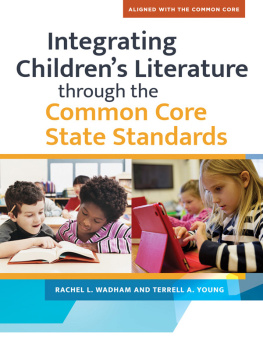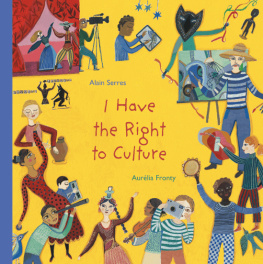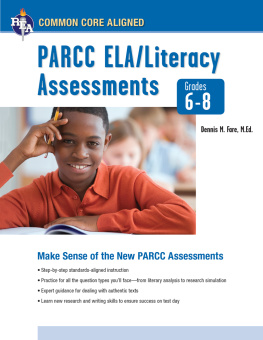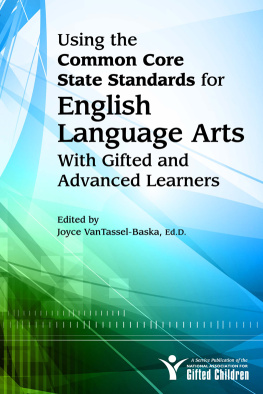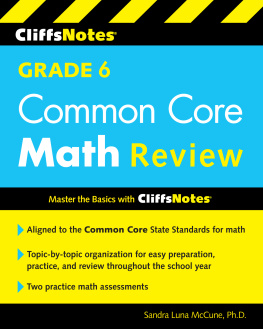Integrating Childrens Literature through the Common Core State Standards
Integrating Childrens Literature through the Common Core State Standards
Rachel L. Wadham and Terrell A. Young
Copyright 2015 by Rachel L. Wadham and Terrell A. Young
All rights reserved. No part of this publication may be reproduced, stored in a retrieval system, or transmitted, in any form or by any means, electronic, mechanical, photocopying, recording, or otherwise, except for the inclusion of brief quotations in a review, without prior permission in writing from the publisher.
Library of Congress Cataloging-in-Publication Data
Wadham, Rachel L., 1973
Integrating childrens literature through the common core state standards / Rachel L. Wadham and Terrell A. Young.
pages cm
Includes bibliographical references and index.
ISBN 978-1-61069-608-1 (pbk : alk. paper) ISBN 978-1-61069-609-8 (ebook)
1.Reading (Elementary)2.Childrens literatureStudy and teaching (Elementary)3.Language arts (Elementary)StandardsUnited States.4.Reading comprehension.5.ChildrenBooks and readingUnited States.I.Young, Terrell A.II.Title.
LB1573.W18 2015
372.4dc232015008164
ISBN: 978-1-61069-608-1
EISBN: 978-1-61069-609-8
191817161512345
This book is also available on the World Wide Web as an eBook.
Visit www.abc-clio.com for details.
Libraries Unlimited
An Imprint of ABC-CLIO, LLC
ABC-CLIO, LLC
130 Cremona Drive, P.O. Box 1911
Santa Barbara, California 93116-1911
This book is printed on acid-free paper 
Manufactured in the United States of America
Contents
In 2009 the landscape of education changed with the development of the Common Core State Standards (CCSS). Since their initial development and the subsequent implementation efforts, the Core has had both its advocates and its detractors. No matter how the Core is characterized, the reality is that the CCSS has had and will continue to have a major impact on education. The effort to develop standards and accountability measures is really nothing new for the field of education; however, the development of the CCSS did represent some rather radical shifts in thinking, as it created standards philosophically grounded in research that could be applied across state lines.
Believing that essential reform in education was needed to make American students more globally competitive and to ensure that students were prepared for the demands of 21st-century colleges and workplaces, several groups initiated a joint effort to create a common set of research-based educational standards. The National Governors Association Center for Best Practices and the Council of Chief State School Officers led the effort. These two groups also worked with Achieve Inc., an education reform group based in Washington, D.C. The Bill & Melinda Gates Foundation, the Charles Stewart Mott Foundation, and other private groups provided funding. The impetus for this work was grounded in the long-term movement toward accountability and standards-based reform that began in the early 1990s. During the early period of this movement, states created their own standards and worked under various systems of accountability, many of which were federally mandated through the No Child Left Behind Act. Finding these efforts lacking and with the act showing its age, these school and state government leaders began to seek out a way to create a more universal set of standards that all states could adopt. The work of this group to reexamine educational benchmarks and devise new approaches for assessment resulted in the CCSS that were released in June 2010. As of January 2015, 43 states and the District of Columbia have individually and voluntarily committed to the adoption of the English language arts (ELA) and mathematics standards in varying combinations.
The history, present, and future of the Core is a very complex issue, and providing a complete picture of its development and implementation is not within the scope of this book. A close reading of the Core documentation will provide much of this information for those with interest. Additionally works such as Something in Common by Rothman and Common Core Meets Education Reform by Hess and McShane are suggested as reliable and comprehensive resources. Since the philosophy and ideas that inform the Core are clearly outlined in these and other works, here is offered only clarifications for several important issues surrounding the Core that will inform the philosophy and ideas to be outlined in this book.
It is significant to clarify that the Core is only a set of standards. At its most basic, a standard is a statement or rule that helps us ensure quality. The implication is that in applying a standard, a certain level of quality will be met. There have been and always will be standards for manufacturing, business, government, and even education. No matter what their realm is, standards are intended to provide a foundational level of quality. This all holds true for the Core. As stated in the CCSS documentation, these standards are designed to provide a clear statement of what students are expected to learn in grades K12 in regards to reading, writing, speaking, listening, and mathematics.
Aimed at professionals, such as teachers, administrators, and librarians, and other stakeholders, including support staff, parents, and the community, the Core shows us what outcomes we can expect for quality student learning. The Core is not by definition or application a curriculum or pedagogy. The Core outlines only the outcomes of performance, meaning they describe what students ought to be able to do (make inferences from a text, for instance), but they do not describe how teachers should reach this goal (curriculum), how it should be taught, or what tools should be used (pedagogy). Understanding what the Core is and what it is not is important for building the context of this book. This book will use the standards as a basis to build a vision of what curriculum and pedagogy could potentially look like when implemented in a classroom. Here is provided one interpretation of the Core using the versatile tool of childrens literature as a foundation.
Because the Core only outlines standards that should be met, the reality is that the Core leaves much room to interpretation. The interpretation of the standards into actual curriculum and pedagogy that can be implemented into the classroom is left up to individual teachers, schools, and districts. In fact, one of the most fundamental aspects of the Core is how much stock it puts into the discretion of teachers to create their own classrooms. The Core clearly states in a variety of ways throughout its documentation that it is up to teachers to apply their professional knowledge, judgment, and experience to determine what tools and applications will be the most helpful for them and their students as they work toward meeting the goals of the Core.
Although many have misinterpreted the Core by saying that it advocates for certain texts and tools, there is nothing further from the truth. The standards do not define how a teacher should teach or what they should teach with. The Core builds only a robust system for judging and applying texts and tasks of all varieties into all classroom situations. It is then up to individual teachers and schools to apply these standards in a way that is best suited to the contexts in which they work. The potential to use a wide range of techniques and tools in the classroom is an exciting prospect, but it can be a little daunting. The purpose of this book is to help bridge that gap between excitement and fear and to provide a vision of just how the Core can be interpreted and applied using trade books written for children as a fundamental tool.

